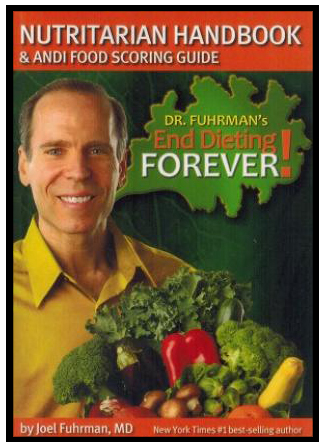“ANDI” for Weight Loss?
Column #178 
In 2003 Dr. Joel Fuhrman started promoting his Aggregate Nutrient Density Index (ANDI) diet for losing weight and regaining health. The ANDI diet is based on the nutrient density formula he created which he calls the “Health Equation” which is: Health = Nutrients/Calories.
His formula ranks vegetables, especially dark green leafy vegetables, at the top. Consequently Fuhrman advises eating at least one pound of raw vegetables and another pound of cooked vegetables each day. His approach, which tends to make him a stealth vegetarian and anti-meat advocate, has some serious flaws.
There is no question that when people follow the ANDI diet they will lose weight. But it’s a diet that’s safe only in the short-term. That’s because over time it will likely cause massive muscle loss.
The Health Equation calculation starts by determining an equal-calorie serving of each food to be evaluated. Then that serving is analyzed on the basis of 34 important nutritional parameters which are then divided by its calories. The lowest calorie foods that are highest in those 34 nutrients will have the highest ANDI index.
The nutrients in the evaluation are: fiber, calcium, iron, magnesium, phosphorus, potassium, zinc, copper, manganese, selenium, vitamin A, beta carotene, alpha carotene, lycopene, lutein and zeaxanthin, vitamin E, vitamin C, thiamin, riboflavin, niacin, pantothenic acid, vitamin B6, folate, vitamin B12, choline, vitamin K, phytosterols, glucosinolates, angiogenesis inhibitors, organosulfides, aromatase inhibitors, resistant starch, resveratrol plus ORAC score. ORAC (Oxygen Radical Absorbance Capacity) is a measure of the antioxidant or radical scavenging capacity of a food.
For consistency, the 34 nutritional parameters are converted to a percentage of their Dietary Reference Intake (DRI) or “assumed” DRIs in the absence of actual DRIs. The raw point totals are then adjusted so that the highest ranking foods (leafy green vegetables) receive a score of 1000. Vegetables such as kale, mustard/turnip/collard greens, Swiss chard, and upland/watercress rank 1,000. All other foods will rank lower.
Kale is nutrient dense and diverse. Yet 100 grams of kale has only 50 calories. Calories in beef depend on the cut, therefore 100 grams of beef may have 200 to 400 calories. If kale and beef have similar nutrient densities and diversities yet beef’s calorie divisor being maybe eight times higher, beef’s ANDI index will be like dividing 1000 by eight, or 125, which puts it way down on the ANDI list. Because only 34 nutrients are evaluated, most of the nutrients in meats and other foods are ignored. Coupled with meat usually having more calories than vegetables, the official ANDI list ranks chicken breast at 24, ground beef (85% lean) at 21, and feta cheese at 20!
Assume we eat a pound of raw kale and a pound of cooked kale. The pound of raw kale has 224 calories. The pound of cooked kale has 161 calories. The total caloric intake is 385. So how many calories are required to maintain your weight? The rough rule of thumb is 10 calories for every pound you weigh. If you weigh 120 pounds, you need 1,200 calories a day with a sedentary lifestyle. The two pounds of kale ends up being a starvation diet. Depending on the cut and fat percent, two pounds of beef provides somewhere around 1,814 to 3,628 calories. Two pounds of beef a day is a lot of beef. Two pounds of kale will not be very satisfying.
The ANDI formula for measuring nutrients is flawed. It ignores both the balance of Omega-6 to Omega-3 essential fatty acids (EFAs) and glycemic loads. Although kale isn’t a problem because it is well balanced and low glycemic. All high energy foods are ranked very low even when they are nutrient dense and diverse. It focuses on only 34 nutrients. It does not take into account the daily caloric needs an individual must have to support life without wasting away. For these reasons I think the ANDI diet can be dangerous to your health. Yes, the correct vegetables will provide the nutrients your body requires along with considerable fiber. But insufficient energy needs will not maintain your body and brain over time. Therefore, to survive the body will cannibalize its own muscles and fat.
If losing weight and improving health at the same time is the goal, then we should pay close attention to “An Increase in the Omega-6/Omega-3 Fatty Acid Ratio Increases the Risk for Obesity” by Dr. Artemis P. Simopoulos. Yes, the study points out that nutrient density is important. But nutrient diversity, the 1:1 EFA balance, and glycemic loads are also important.
The foods I prefer are grass-fed and Omega-3 meats, wild-caught seafood, and all low glycemic vegetables that are also nutrient dense and diverse with close to 1:1 EFA balances. My experience has been that these foods help my body manage its weight far better than trying to manage my weight with strenuous workouts and starvation.
To your health.
Ted Slanker
Ted Slanker has been reporting on the fundamentals of nutritional research in publications, television and radio appearances, and at conferences since 1999. He condenses complex studies into the basics required for health and well-being. His eBook, The Real Diet of Man, is available online.
Don’t miss these links for additional reading:
Dr. Joel Fuhrman from RationalWiki
Eat to Live by Lisa Schweitzer from WebMD
How Many Calories Do You Need? by Carole Carson from AARP
An Increase in the Omega-6/Omega-3 Fatty Acid Ratio Increases the Risk for Obesity by Dr. Artemis P. Simopoulos
CDC Superfoods? Why The Food Nutrient ANDI Score Is Flawed by Dave Asprey
Solution to Obesity: Let’s Eat by Ted Slanker
Aggregate Nutrient Density Index (ANDI) Nutrient Density Guide
Food Analysis: GI, GL, Fat Ratio, Nutrient Load by Ted Slanker




